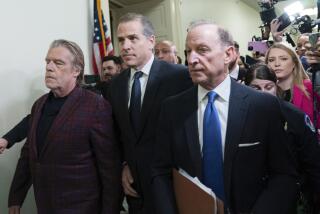Outside Texas, alarm over textbook changes
When Texas’ conservative-leaning Board of Education voted for new social studies standards this month, parents, teachers and lawmakers far beyond the Lone Star state -- particularly the liberal ones -- took notice.
With the changes, Texas’ curriculum is likely to de-emphasize the concept in U.S. history of separating church and state, and the influence of Thomas Jefferson on 18th century world history. It would also cast a positive light on conservatives, such as Phyllis Schlafly and the late Sen. Joseph McCarthy.
Concerned observers have warned that those ideas could seep into textbooks throughout the country, because Texas is one of the nation’s largest textbook buyers. In California last week, state Sen. Leland Yee (D-San Francisco) announced that he was working out the details of legislation that would inoculate California students from the Texas version of history.
“While some Texas politicians may want to set their educational standards back 50 years, California should not be subject to their backward curriculum changes,” he said.
But it is far from clear that non-Texans will be subjected to the proposed changes, once they are finalized, as expected, in May. Though none of the three major K-12 textbook publishers -- Pearson Education Inc., Houghton Mifflin Harcourt and McGraw-Hill -- would comment for this article, observers of the $8-billion industry offered differing views on the likelihood that Texas could wield such influence beyond its borders -- in part because the textbook business, like American history itself, is a fluid affair influenced by commerce, culture, legislation and technology.
Texas and California are not just the two largest textbook markets in the nation. They are also among 20 states that industry insiders refer to as “adoption” states, meaning that they choose which textbooks can be used statewide. The remaining states let local schools and districts essentially choose whatever books they want, as long as the students who read them meet state-mandated standards.
Many states did not adopt such standards until they were compelled to by the 1994 Improving America’s Schools Act, a major plank of President Clinton’s education reform effort.
Before 1994, many schools bought largely uniform “national editions” of textbooks, said Jay Diskey, executive director of the school division for the Assn. of American Publishers. Back then, he acknowledged, big states such as California, New York and Texas were able to muscle in extra pages in national textbooks on, say, the Gold Rush or the Battle of the Alamo.
But since then, Diskey argued, publishers have grown accustomed to regularly printing different textbooks to conform to different states’ needs. The new Texas standards, he said, won’t change that.
“It’s gotten to be an exaggeration, if not an urban legend, about how curriculum in Texas automatically hops state lines,” he said.
Diskey also noted that the computerization of the publishing industry has made it possible to swap pages and chapters in textbooks to meet differing expectations.
Publishers may become even more nimble as digital publishing becomes more widespread, and as educators move closer to the e-book model promised by the iPad and the Kindle.
“It’s already happening in the college textbook market,” said Laura Dawson, a New York-based consultant to the publishing industry. “Professors can put together what would amount to a mash-up, where they can mix and match content to create a custom book just for their class. I definitely see that trickling down.”
Critics of the current system argue that textbook manufacturers don’t so much offer variety as they do texts crammed with every special request from around the country -- creating books that are often unwieldy and unreadable.
They also point to forces that may be limiting the variety of textbooks on the market. One is the consolidation of the textbook industry. Ten or 15 years ago, there were more than a dozen major players cranking out schoolbooks; now the three largest companies are responsible for about 80% of the core K-12 textbook market, Diskey said.
Another factor that could limit textbook variety nationwide is the California budget crisis.
California has traditionally served as the liberal and multicultural yin to the Texas yang in the industry. But in July, the Legislature suspended, until 2013, the adoption of new educational materials. That gave cash-strapped districts a break from having to buy updated textbooks.
“That means that California right now is of much less importance to publishers making decisions about content,” said Gilbert Sewall, director of the American Textbook Council, a research center.
richard.fausset@ latimes.com
More to Read
Start your day right
Sign up for Essential California for news, features and recommendations from the L.A. Times and beyond in your inbox six days a week.
You may occasionally receive promotional content from the Los Angeles Times.






